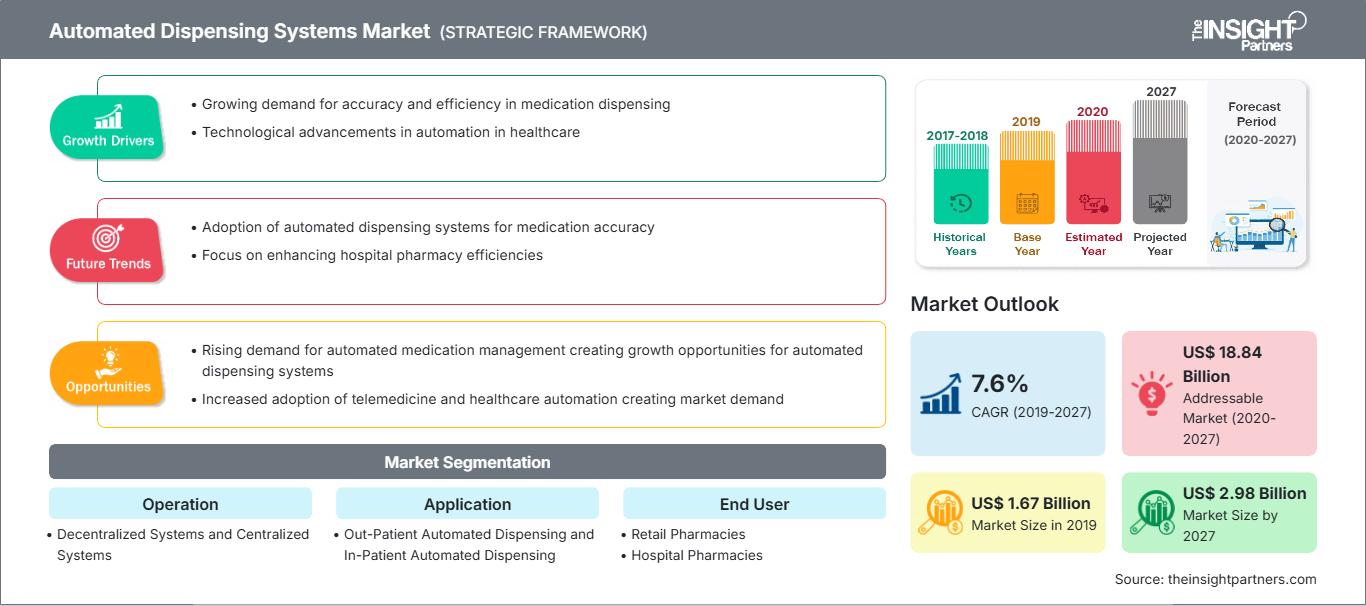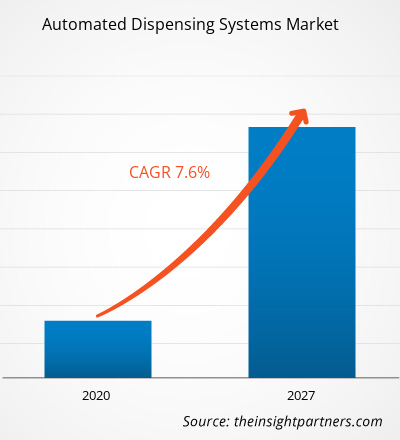Se prevé que el mercado de sistemas de dispensación automatizados alcance los 2.980,38 millones de dólares estadounidenses en 2027, frente a los 1.665,78 millones de dólares estadounidenses en 2019; se estima que crecerá a una tasa de crecimiento anual compuesta (TCAC) del 7,6% durante el período 2020-2027.
Los sistemas automatizados de dispensación, también conocidos como armarios automatizados para medicamentos, son dispositivos electrónicos para el almacenamiento y la dispensación de fármacos, utilizados principalmente en entornos sanitarios. Estos sistemas facilitan el seguimiento y el control de la distribución de medicamentos; están protegidos con contraseñas autenticadas y biometría para el control de inventario y la seguridad de los fármacos contra robos. Se han destacado como una de las herramientas con mayor potencial para mejorar la eficiencia operativa y la seguridad del paciente. Además, actualmente se utilizan ampliamente en clínicas y residencias de ancianos, entre otros. Los sistemas automatizados de dispensación contribuyen a transformar los hospitales en instituciones más seguras, eficientes y eficaces.
El mercado global de sistemas de dispensación automatizada está impulsado por factores como el aumento de los errores de medicación y el envejecimiento de la población. Sin embargo, los problemas asociados a estos sistemas, como la introducción incorrecta de datos en los programas y las averías de los equipos, entre otros, pueden frenar su crecimiento. Además, los mercados emergentes ofrecen oportunidades de crecimiento para los participantes del mercado.
Obtendrá personalización gratuita de cualquier informe, incluyendo partes de este informe, análisis a nivel de país y paquetes de datos de Excel. Además, podrá aprovechar excelentes ofertas y descuentos para empresas emergentes y universidades.
Mercado de sistemas de dispensación automatizados: Perspectivas estratégicas

- Obtenga las principales tendencias clave del mercado que se describen en este informe.Esta muestra GRATUITA incluirá análisis de datos, que abarcarán desde tendencias de mercado hasta estimaciones y pronósticos.
Perspectivas del mercado
Aumento de los errores de medicación
Una administración de medicamentos irracional, inapropiada e ineficaz puede provocar errores graves que perjudiquen a los pacientes. Algunos de los errores más comunes son la administración de un medicamento equivocado, una cantidad incorrecta, una dosis errónea o la omisión de algún medicamento. Aproximadamente el 75 % de estos errores se deben a distracciones, ya que los profesionales sanitarios están ocupados con múltiples tareas, como la exploración de pacientes, la comunicación con especialistas, con familiares de pacientes y con representantes de las aseguradoras.
Anualmente, la Administración de Alimentos y Medicamentos de los Estados Unidos (FDA) recibe más de 100 000 informes relacionados con errores de medicación. Además, según el estudio «Errores de medicación», publicado en StatPearls en junio de 2020, entre 7000 y 9000 personas mueren cada año en Estados Unidos debido a errores de medicación. Asimismo, según las estimaciones publicadas en el estudio «Prevalencia y carga económica de los errores de medicación en el NHS de Inglaterra» en 2018, se producen aproximadamente 237 millones de errores de medicación al año en el NHS, y las reacciones adversas a medicamentos (RAM) evitables provocan cientos de muertes.
Perspectivas basadas en la operación
Según su funcionamiento, el mercado de sistemas de dispensación automatizada se divide en sistemas descentralizados y centralizados. El segmento de sistemas centralizados ostentó una mayor cuota de mercado en 2019 debido a factores como la creciente necesidad de reducir costes, garantizar la disponibilidad de medicamentos y modernizar la asignación de recursos. Además, se prevé que los sistemas descentralizados registren una mayor tasa de crecimiento anual compuesto (TCAC) durante el periodo de previsión.
Información basada en aplicaciones
Según su aplicación, el mercado de sistemas de dispensación automatizada se divide en dispensación automatizada para pacientes hospitalizados y dispensación automatizada para pacientes ambulatorios. El segmento de dispensación automatizada para pacientes hospitalizados representó la mayor parte del mercado en 2019; sin embargo, se prevé que la dispensación automatizada para pacientes ambulatorios registre una mayor tasa de crecimiento anual compuesto (TCAC) durante el período de pronóstico.
Información basada en el usuario final
Según el usuario final, el mercado de sistemas de dispensación automatizada se segmenta en farmacias hospitalarias, farmacias minoristas y otros. El segmento de farmacias hospitalarias ostentó la mayor cuota de mercado en 2019; sin embargo, se prevé que el segmento de farmacias minoristas registre la mayor tasa de crecimiento anual compuesto (TCAC) durante el período de pronóstico.
El lanzamiento y la aprobación de productos son estrategias comunes que adoptan las empresas para expandir su presencia global y su cartera de productos; estas estrategias les ayudan a satisfacer la creciente demanda de los consumidores. La colaboración es una de las principales estrategias que adoptan los actores del mercado de sistemas de dispensación automatizada para ampliar su base de clientes en todo el mundo, lo que también les permite mantener su marca a nivel global.
Perspectivas regionales del mercado de sistemas de dispensación automatizados
Los analistas de The Insight Partners han explicado en detalle las tendencias regionales y los factores que influyen en el mercado de sistemas de dispensación automatizada durante el período de previsión. Esta sección también analiza los segmentos y la geografía del mercado de sistemas de dispensación automatizada en Norteamérica, Europa, Asia Pacífico, Oriente Medio y África, y Sudamérica y Centroamérica.
Alcance del informe de mercado de sistemas de dispensación automatizados
| Atributo del informe | Detalles |
|---|---|
| Tamaño del mercado en 2019 | 1.670 millones de dólares estadounidenses |
| Tamaño del mercado para 2027 | US$ 2.980 millones |
| Tasa de crecimiento anual compuesto global (2019 - 2027) | 7,6% |
| Datos históricos | 2017-2018 |
| período de previsión | 2020-2027 |
| Segmentos cubiertos | Por operación
|
| Regiones y países cubiertos | América del norte
|
| Líderes del mercado y perfiles de empresas clave |
|
Densidad de los participantes en el mercado de sistemas de dispensación automatizada: comprensión de su impacto en la dinámica empresarial
El mercado de sistemas de dispensación automatizada está creciendo rápidamente, impulsado por la creciente demanda de los usuarios finales debido a factores como la evolución de las preferencias de los consumidores, los avances tecnológicos y una mayor conciencia de los beneficios del producto. A medida que aumenta la demanda, las empresas amplían su oferta, innovan para satisfacer las necesidades de los consumidores y aprovechan las nuevas tendencias, lo que impulsa aún más el crecimiento del mercado.

- Obtenga una visión general de los principales actores del mercado de sistemas de dispensación automatizados.
Mercado global de sistemas de dispensación automatizados: por operación
- Sistemas descentralizados
- Sistemas centralizados
Mercado global de sistemas de dispensación automatizados: por aplicación
- Dispensación automatizada para pacientes ambulatorios
- Dispensación automatizada para pacientes hospitalizados
Mercado global de sistemas de dispensación automatizados: por usuario final
- Farmacias minoristas
- Farmacias hospitalarias
- Otros
Mercado de sistemas de dispensación automatizados: por geografía
- América del norte
- A NOSOTROS
- Canadá
- México
- Europa
- Francia
- Alemania
- Italia
- Reino Unido
- España
- El resto de Europa
- Asia Pacífico (APAC)
- Porcelana
- India
- Corea del Sur
- Japón
- Australia
- Resto de Asia Pacífico
- Oriente Medio y África (MEA)
- Sudáfrica
- Arabia Saudita
- Emiratos Árabes Unidos
- Resto de Oriente Medio y África
- América del Sur y Central
- Brasil
- Argentina
- El resto de Sudamérica
Perfiles de empresas
- Corporación Cerner
- Capsa Healthcare
- Omnicell, Inc
- BD
- ARxIUM
- Accu-Chart Plus Healthcare Systems, Inc
- Asociados de Innovación
- RxMedic Systems, Inc
- Swiss Log Holding Ltd.
- Willach Farmacia Soluciones GmbH
- Análisis histórico (2 años), año base, pronóstico (7 años) con CAGR
- Análisis PEST y FODA
- Tamaño del mercado, valor/volumen: global, regional y nacional
- Industria y panorama competitivo
- Conjunto de datos de Excel
Informes recientes
Testimonios
Razón para comprar
- Toma de decisiones informada
- Comprensión de la dinámica del mercado
- Análisis competitivo
- Información sobre clientes
- Pronósticos del mercado
- Mitigación de riesgos
- Planificación estratégica
- Justificación de la inversión
- Identificación de mercados emergentes
- Mejora de las estrategias de marketing
- Impulso de la eficiencia operativa
- Alineación con las tendencias regulatorias




















 Obtenga una muestra gratuita para - Mercado de sistemas de dispensación automatizados
Obtenga una muestra gratuita para - Mercado de sistemas de dispensación automatizados